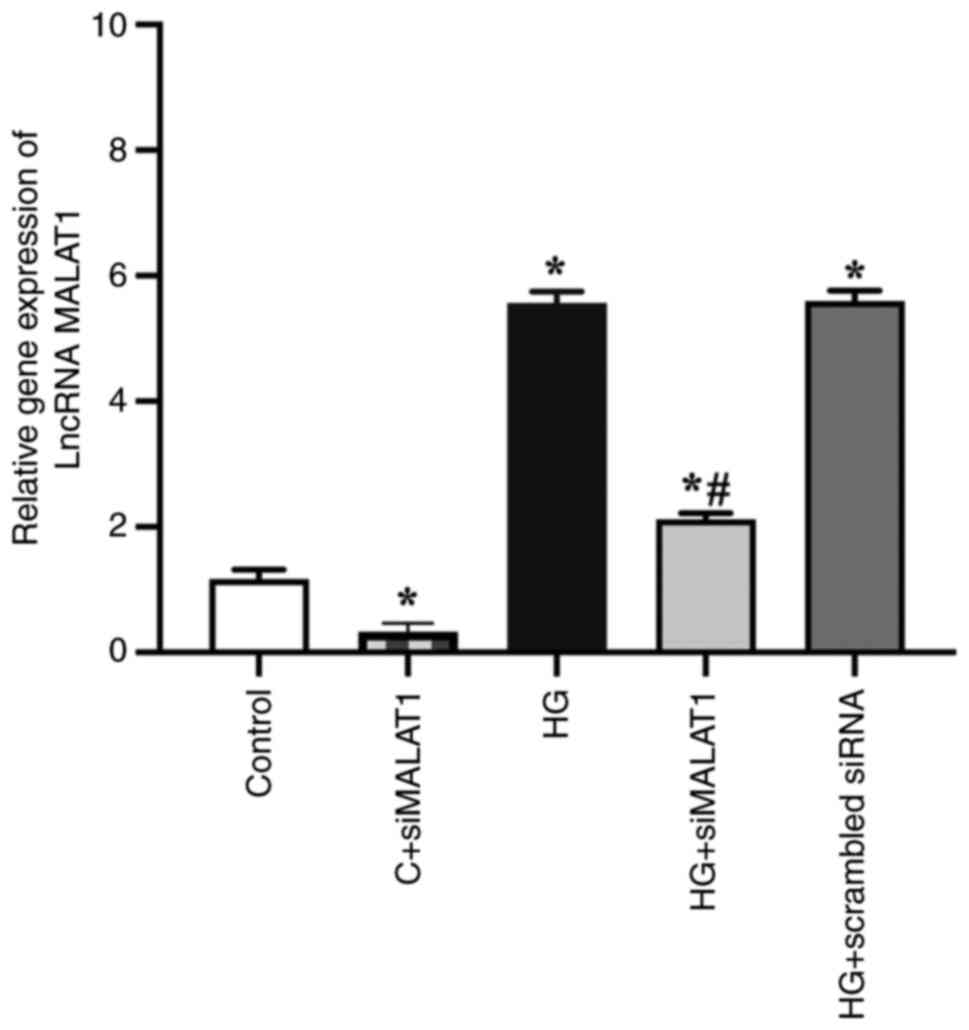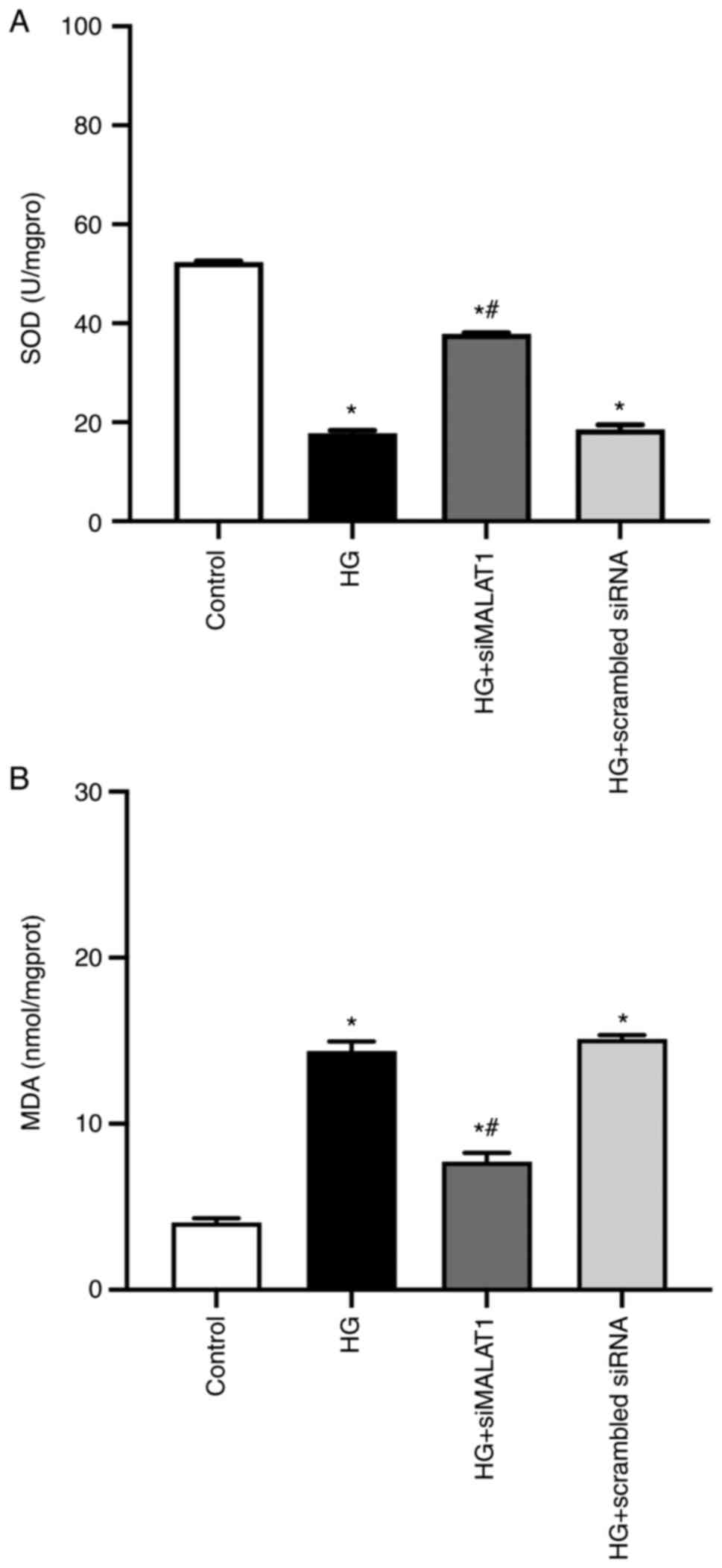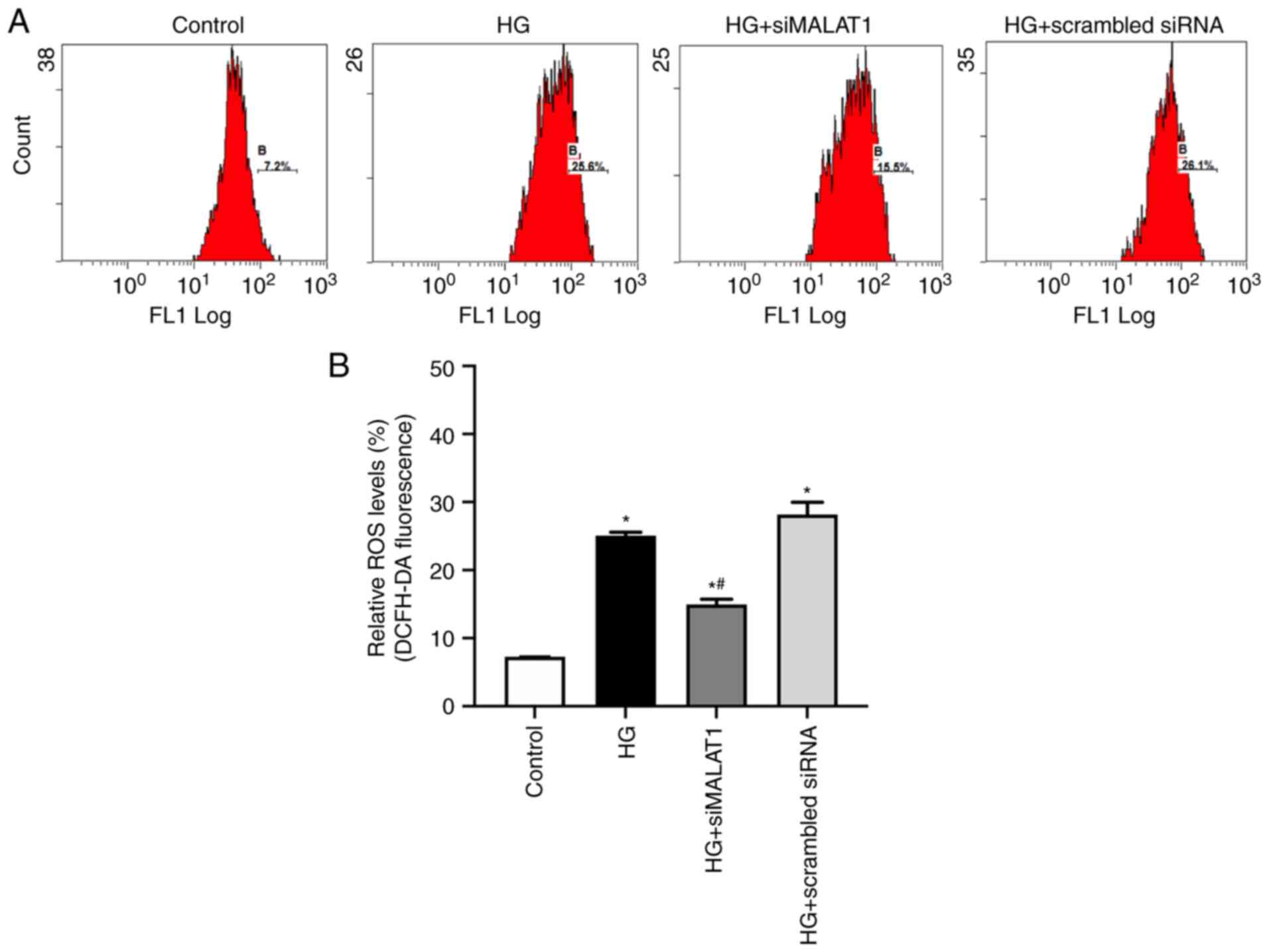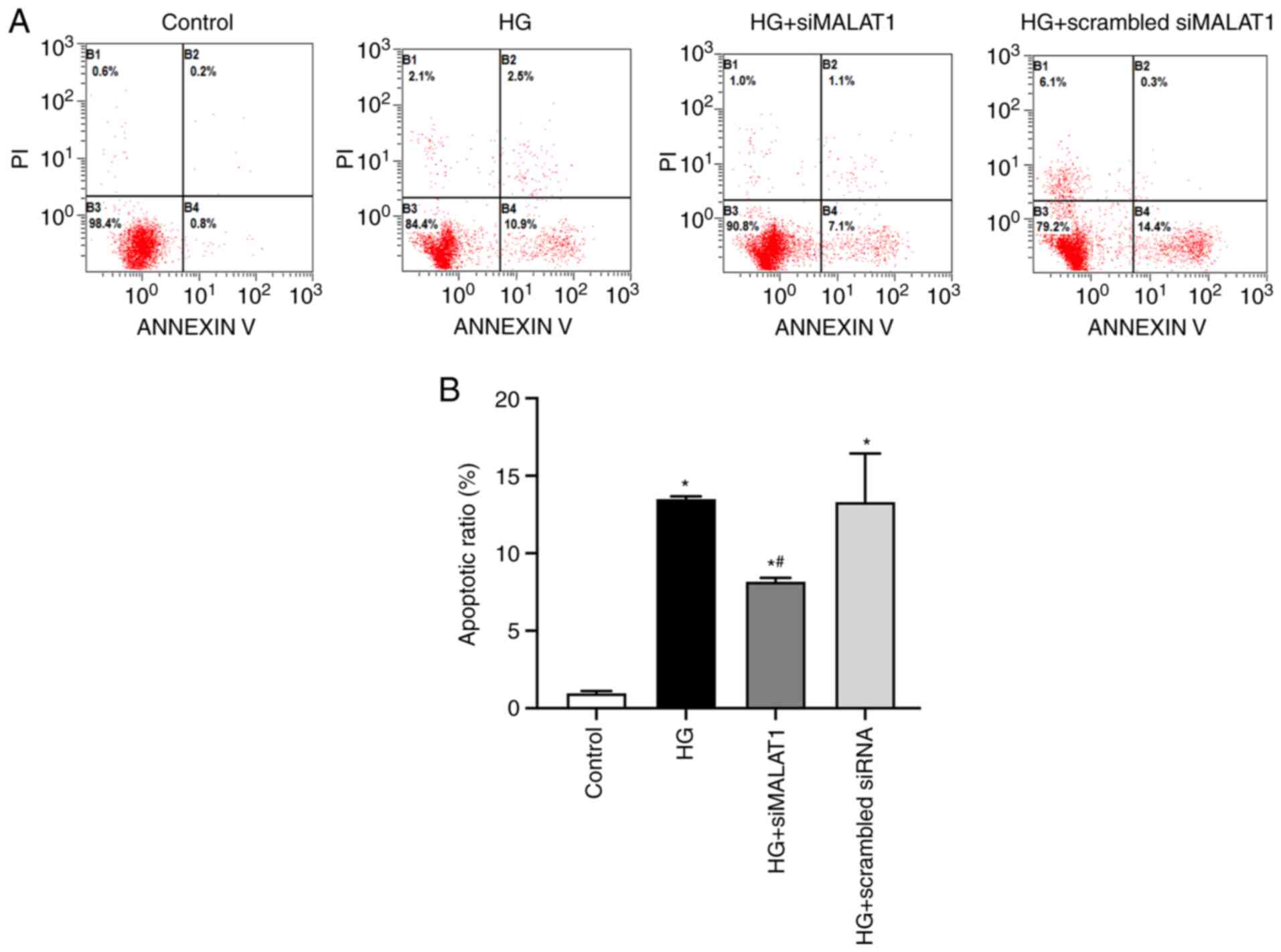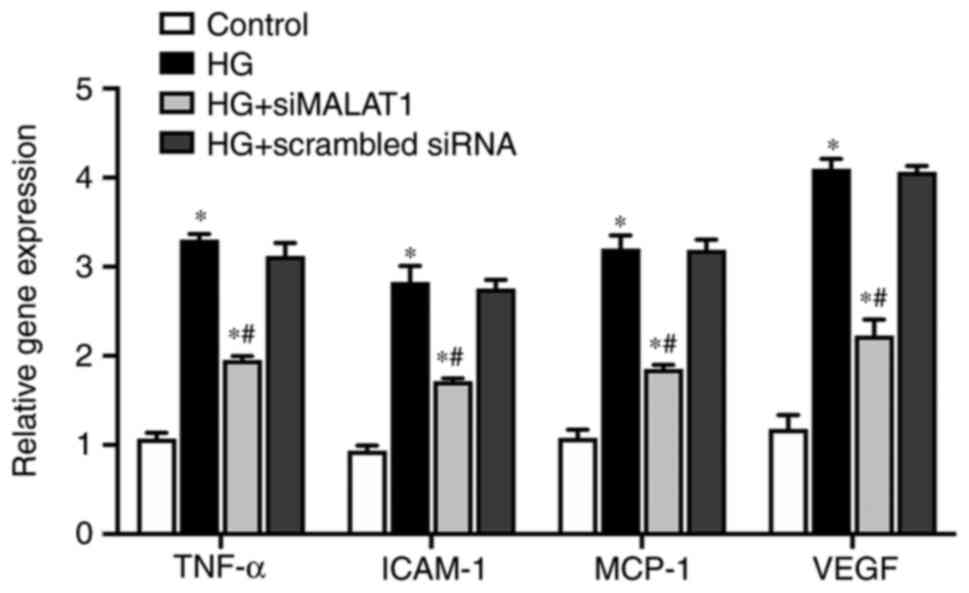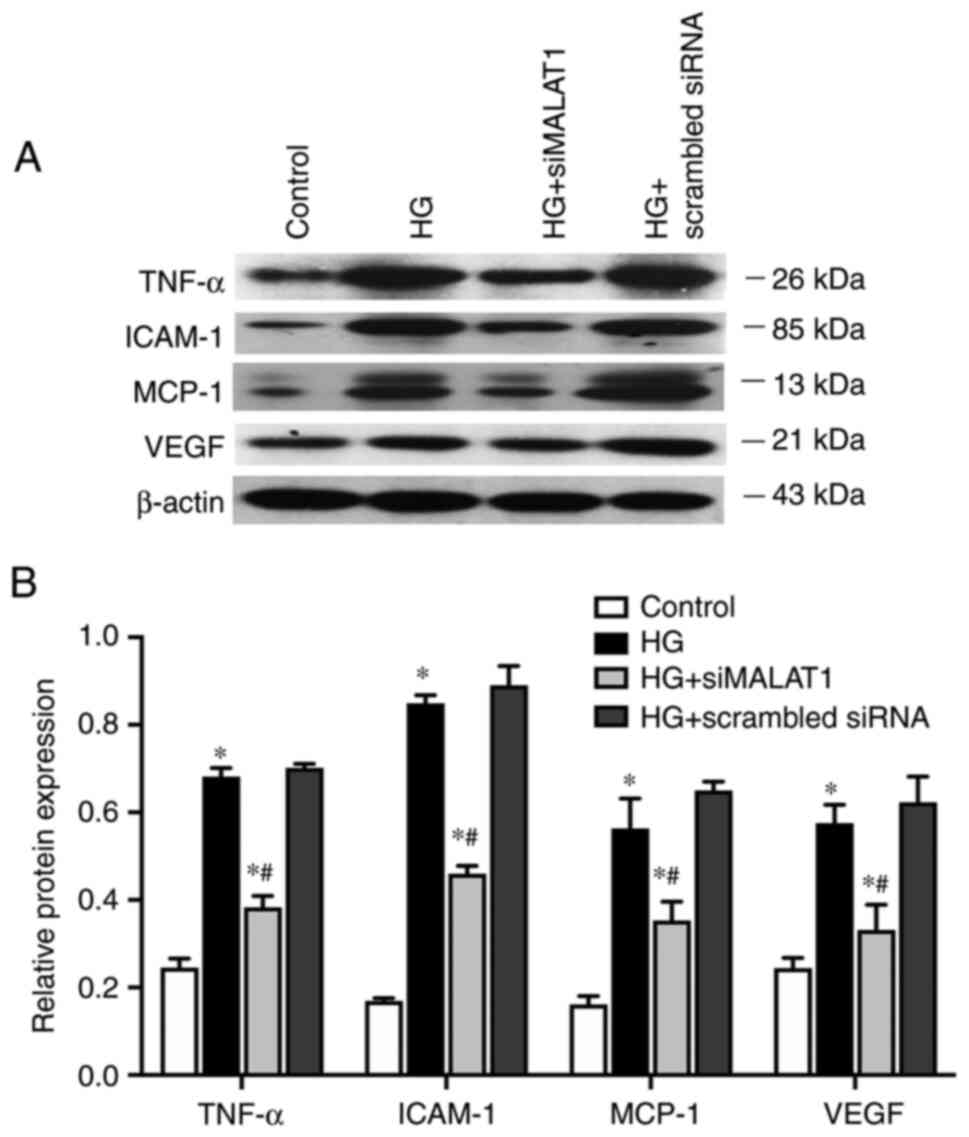|
1
|
Wong TY, Cheung CM, Larsen M, Sharma S and
Simó R: Diabetic retinopathy. Nat Rev Dis Primers. 2:160122016.
View Article : Google Scholar : PubMed/NCBI
|
|
2
|
Saaddine JB, Honeycutt AA, Narayan KM,
Zhang X, Klein R and Boyle JP: Projection of diabetic retinopathy
and other major eye diseases among people with diabetes mellitus:
United States, 2005-2050. Arch Ophthalmol. 126:1740–1747. 2008.
View Article : Google Scholar : PubMed/NCBI
|
|
3
|
Mazhar K, Varma R, Choudhury F,
McKean-Cowdin R, Shtir CJ and Azen SP; Los Angeles Latino Eye Study
Group, : Severity of diabetic retinopathy and health-related
quality of life: The Los Angeles latino eye study. Ophthalmology.
118:649–655. 2011. View Article : Google Scholar : PubMed/NCBI
|
|
4
|
Amadio M, Pascale A, Cupri S, Pignatello
R, Osera C, D'Agata V, D'Amico AG, Leggio GM, Ruozi B, Govoni S, et
al: Nanosystems based on siRNA silencing HuR expression counteract
diabetic retinopathy in rat. Pharmacol Res. 111:713–720. 2016.
View Article : Google Scholar : PubMed/NCBI
|
|
5
|
Xu HZ and Le YZ: Significance of outer
blood-retina barrier breakdown in diabetes and ischemia. Invest
Ophthalmol Vis Sci. 52:2160–2164. 2011. View Article : Google Scholar : PubMed/NCBI
|
|
6
|
Tarchick MJ, Bassiri P, Rohwer RM and
Samuels IS: Early functional and morphologic abnormalities in the
diabetic nyxnob mouse retina. Invest Ophthalmol Vis Sci.
57:3496–3508. 2016. View Article : Google Scholar : PubMed/NCBI
|
|
7
|
Simó R, Villarroel M, Corraliza L,
Hernández C and Garcia-Ramírez M: The retinal pigment epithelium:
Something more than a constituent of the blood-retinal
barrier-implications for the pathogenesis of diabetic retinopathy.
J Biomed Biotechnol. 2010:1907242010. View Article : Google Scholar : PubMed/NCBI
|
|
8
|
Li H, Li R, Wang L, Liao D, Zhang W and
Wang J: Proanthocyanidins attenuate the high glucose-induced damage
of retinal pigment epithelial cells by attenuating oxidative stress
and inhibiting activation of the NLRP3 inflammasome. J Biochem Mol
Toxicol. 35:e228452021. View Article : Google Scholar : PubMed/NCBI
|
|
9
|
Li W and Xiao H: Dihydromyricetin
alleviates high glucose-induced oxidative stress and apoptosis in
human retinal pigment epithelial cells by downregulating miR-34a
expression. Diabetes Metab Syndr Obes. 14:387–397. 2021. View Article : Google Scholar : PubMed/NCBI
|
|
10
|
Xiao H and Liu Z: Effects of microRNA-217
on high glucose-induced inflammation and apoptosis of human retinal
pigment epithelial cells (ARPE-19) and its underlying mechanism.
Mol Med Rep. 20:5125–5133. 2019.PubMed/NCBI
|
|
11
|
Kim DI, Park MJ, Lim SK, Choi JH, Kim JC,
Han HJ, Kundu TK, Park JI, Yoon KC, Park SW, et al:
High-glucose-induced CARM1 expression regulates apoptosis of human
retinal pigment epithelial cells via histone 3 arginine 17
dimethylation: Role in diabetic retinopathy. Arch Biochem Biophys.
560:36–43. 2014. View Article : Google Scholar : PubMed/NCBI
|
|
12
|
Yin L, Sun Z, Ren Q, Su X and Zhang D:
Long non-coding RNA BANCR is overexpressed in patients with
diabetic retinopathy and promotes apoptosis of retinal pigment
epithelial cells. Med Sci Monit. 25:2845–2851. 2019. View Article : Google Scholar : PubMed/NCBI
|
|
13
|
Kutty RK, Samuel W, Duncan T, Postnikova
O, Jaworski C, Nagineni CN and Redmond TM: Proinflammatory cytokine
interferon-γ increases the expression of BANCR, a long non-coding
RNA, in retinal pigment epithelial cells. Cytokine. 104:147–150.
2018. View Article : Google Scholar : PubMed/NCBI
|
|
14
|
Yang J, Yang K, Meng X, Liu P, Fu Y and
Wang Y: Silenced SNHG1 inhibited epithelial-mesenchymal transition
and inflammatory response of ARPE-19 cells induced by high glucose.
J Inflamm Res. 14:1563–1573. 2021. View Article : Google Scholar : PubMed/NCBI
|
|
15
|
Zhang X, Hamblin MH and Yin KJ: The long
noncoding RNA Malat1: Its physiological and pathophysiological
functions. RNA Biol. 14:1705–1714. 2017. View Article : Google Scholar : PubMed/NCBI
|
|
16
|
Biswas S, Thomas AA, Chen S, Aref-Eshghi
E, Feng B, Gonder J, Sadikovic B and Chakrabarti S: MALAT1: An
epigenetic regulator of inflammation in diabetic retinopathy. Sci
Rep. 8:65262018. View Article : Google Scholar : PubMed/NCBI
|
|
17
|
Radhakrishnan R and Kowluru RA: Long
noncoding RNA MALAT1 and regulation of the antioxidant defense
system in diabetic retinopathy. Diabetes. 70:227–239. 2021.
View Article : Google Scholar : PubMed/NCBI
|
|
18
|
Huang K, Yu X, Yu Y, Zhang L, Cen Y and
Chu J: Long noncoding RNA MALAT1 promotes high glucose-induced
inflammation and apoptosis of vascular endothelial cells by
regulating miR-361-3p/SOCS3 axis. Int J Clin Exp Pathol.
13:1243–1252. 2020.PubMed/NCBI
|
|
19
|
Gong W, Zhu G, Li J and Yang X: LncRNA
MALAT1 promotes the apoptosis and oxidative stress of human lens
epithelial cells via p38MAPK pathway in diabetic cataract. Diabetes
Res Clin Pract. 144:314–321. 2018. View Article : Google Scholar : PubMed/NCBI
|
|
20
|
Jiang Z, Zeng Q, Li D, Ding L, Lu W, Bian
M and Wu J: Long non-coding RNA MALAT1 promotes high
glucose-induced rat cartilage endplate cell apoptosis via the
p38/MAPK signalling pathway. Mol Med Rep. 21:2220–2226.
2020.PubMed/NCBI
|
|
21
|
Zhao X, Wang J, Li P, Tang L and Bai Y:
Casein kinase 2-interacting protein-1 alleviates high
glucose-reduced autophagy, oxidative stress, and apoptosis in
retinal pigment epithelial cells via activating the p62/KEAP1/NRF2
signaling pathway. J Ophthalmol. 2021:66940502021. View Article : Google Scholar : PubMed/NCBI
|
|
22
|
Li T, Niu L, Li M, Liu Y, Xu Z, Gao X and
Liu D: Effects of small interfering RNA-mediated downregulation of
the Krüppel-like factor 4 gene on collagen metabolism in human
hepatic stellate cells. Mol Med Rep. 12:3972–3978. 2015. View Article : Google Scholar : PubMed/NCBI
|
|
23
|
Livak KJ and Schmittgen TD: Analysis of
relative gene expression data using real-time quantitative PCR and
the 2(−Delta Delta C(T)) method. Methods. 25:402–408. 2001.
View Article : Google Scholar : PubMed/NCBI
|
|
24
|
Ho E, Karimi Galougahi K, Liu CC, Bhindi R
and Figtree GA: Biological markers of oxidative stress:
Applications to cardiovascular research and practice. Redox Biol.
1:483–491. 2013. View Article : Google Scholar : PubMed/NCBI
|
|
25
|
Fu SH, Lai MC, Zheng YY, Sun YW, Qiu JJ,
Gui F, Zhang Q and Liu F: MiR-195 inhibits the ubiquitination and
degradation of YY1 by Smurf2, and induces EMT and cell permeability
of retinal pigment epithelial cells. Cell Death Dis. 12:7082021.
View Article : Google Scholar : PubMed/NCBI
|
|
26
|
Tong P, Peng QH, Gu LM, Xie WW and Li WJ:
LncRNA-MEG3 alleviates high glucose induced inflammation and
apoptosis of retina epithelial cells via regulating miR-34a/SIRT1
axis. Exp Mol Pathol. 107:102–109. 2019. View Article : Google Scholar : PubMed/NCBI
|
|
27
|
Dong Y, Wan G, Peng G, Yan P, Qian C and
Li F: Long non-coding RNA XIST regulates hyperglycemia-associated
apoptosis and migration in human retinal pigment epithelial cells.
Biomed Pharmacother. 125:1099592020. View Article : Google Scholar : PubMed/NCBI
|
|
28
|
Yu X, Luo Y, Chen G, Liu H, Tian N, Zen X
and Liu Q: Long noncoding RNA IGF2AS regulates high-glucose induced
apoptosis in human retinal pigment epithelial cells. IUBMB Life.
71:1611–1618. 2019. View
Article : Google Scholar : PubMed/NCBI
|
|
29
|
Ji P, Diederichs S, Wang W, Böing S,
Metzger R, Schneider PM, Tidow N, Brandt B, Buerger H, Bulk E, et
al: MALAT-1, a novel noncoding RNA, and thymosin beta4 predict
metastasis and survival in early-stage non-small cell lung cancer.
Oncogene. 22:8031–8041. 2003. View Article : Google Scholar : PubMed/NCBI
|
|
30
|
Lei L, Chen J, Huang J, Lu J, Pei S, Ding
S, Kang L, Xiao R and Zeng Q: Functions and regulatory mechanisms
of metastasis-associated lung adenocarcinoma transcript 1. J Cell
Physiol. 234:134–151. 2018. View Article : Google Scholar : PubMed/NCBI
|
|
31
|
Abdulle LE, Hao JL, Pant OP, Liu XF, Zhou
DD, Gao Y, Suwal A and Lu CW: MALAT1 as a diagnostic and
therapeutic target in diabetes-related complications: A promising
long-noncoding RNA. Int J Med Sci. 16:548–555. 2019. View Article : Google Scholar : PubMed/NCBI
|
|
32
|
Yan B, Tao ZF, Li XM, Zhang H, Yao J and
Jiang Q: Aberrant expression of long noncoding RNAs in early
diabetic retinopathy. Invest Ophthalmol Vis Sci. 55:941–951. 2014.
View Article : Google Scholar : PubMed/NCBI
|
|
33
|
Liu JY, Yao J, Li XM, Song YC, Wang XQ, Li
YJ, Yan B and Jiang Q: Pathogenic role of lncRNA-MALAT1 in
endothelial cell dysfunction in diabetes mellitus. Cell Death Dis.
5:e15062014. View Article : Google Scholar : PubMed/NCBI
|
|
34
|
Puthanveetil P, Chen S, Feng B, Gautam A
and Chakrabarti S: Long non-coding RNA MALAT1 regulates
hyperglycaemia induced inflammatory process in the endothelial
cells. J Cell Mol Med. 19:1418–1425. 2015. View Article : Google Scholar : PubMed/NCBI
|
|
35
|
Postnikova OA, Rogozin IB, Samuel W,
Nudelman G, Babenko VN, Poliakov E and Redmond TM: Volatile
evolution of long non-coding RNA repertoire in retinal pigment
epithelium: Insights from comparison of bovine and human RNA
expression profiles. Genes (Basel). 10:2052019. View Article : Google Scholar : PubMed/NCBI
|
|
36
|
Zhou RM, Wang XQ, Yao J, Shen Y, Chen SN,
Yang H, Jiang Q and Yan B: Identification and characterization of
proliferative retinopathy-related long noncoding RNAs. Biochem
Biophys Res Commun. 465:324–330. 2015. View Article : Google Scholar : PubMed/NCBI
|
|
37
|
Yang S, Yao H, Li M, Li H and Wang F: Long
non-coding RNA MALAT1 mediates transforming growth factor
beta1-induced epithelial-mesenchymal transition of retinal pigment
epithelial cells. PLoS One. 11:e01526872016. View Article : Google Scholar : PubMed/NCBI
|
|
38
|
Wu MY, Yiang GT, Lai TT and Li CJ: The
oxidative stress and mitochondrial dysfunction during the
pathogenesis of diabetic retinopathy. Oxid Med Cell Longev.
2018:34201872018. View Article : Google Scholar : PubMed/NCBI
|
|
39
|
Yang Q, Li S, Zhou Z, Fu M, Yang X, Hao K
and Liu Y: HDAC6 inhibitor Cay10603 inhibits high glucose-induced
oxidative stress, inflammation and apoptosis in retinal pigment
epithelial cells via regulating NF-κB and NLRP3 inflammasome
pathway. Gen Physiol Biophys. 39:169–177. 2020. View Article : Google Scholar : PubMed/NCBI
|
|
40
|
Li F, Li X, Qiao L, Liu W, Xu C and Wang
X: MALAT1 regulates miR-34a expression in melanoma cells. Cell
Death Dis. 10:3892019. View Article : Google Scholar : PubMed/NCBI
|
|
41
|
Song Y, Yang L, Guo R, Lu N, Shi Y and
Wang X: Long noncoding RNA MALAT1 promotes high glucose-induced
human endothelial cells pyroptosis by affecting NLRP3 expression
through competitively binding miR-22. Biochem Biophys Res Commun.
509:359–366. 2019. View Article : Google Scholar : PubMed/NCBI
|
|
42
|
Maugeri G, Bucolo C, Drago F, Rossi S, Di
Rosa M, Imbesi R, D'Agata V and Giunta S: Attenuation of high
glucose-induced damage in RPE cells through p38 MAPK signaling
pathway inhibition. Front Pharmacol. 12:6846802021. View Article : Google Scholar : PubMed/NCBI
|
|
43
|
Zhang Y, Xi X, Mei Y, Zhao X, Zhou L, Ma
M, Liu S, Zha X and Yang Y: High-glucose induces retinal pigment
epithelium mitochondrial pathways of apoptosis and inhibits
mitophagy by regulating ROS/PINK1/Parkin signal pathway. Biomed
Pharmacother. 111:1315–1325. 2019. View Article : Google Scholar : PubMed/NCBI
|
|
44
|
Gordon AD, Biswas S, Feng B and
Chakrabarti S: MALAT1: A regulator of inflammatory cytokines in
diabetic complications. Endocrinol Diabetes Metab. 1:e000102018.
View Article : Google Scholar : PubMed/NCBI
|
|
45
|
Gong YP, Zhang YW, Su XQ and Gao HB:
Inhibition of long noncoding RNA MALAT1 suppresses high
glucose-induced apoptosis and inflammation in human umbilical vein
endothelial cells by suppressing the NF-κB signaling pathway.
Biochem Cell Biol. 98:669–675. 2020. View Article : Google Scholar : PubMed/NCBI
|
|
46
|
Chen X, Han R, Hao P, Wang L, Liu M, Jin
M, Kong D and Li X: Nepetin inhibits IL-1β induced inflammation via
NF-κB and MAPKs signaling pathways in ARPE-19 cells. Biomed
Pharmacother. 101:87–93. 2018. View Article : Google Scholar : PubMed/NCBI
|
|
47
|
Zhang J, Zhou K, Zhang X, Zhou Y, Li Z and
Shang F: Celastrol ameliorates inflammation in human retinal
pigment epithelial cells by suppressing NF-κB signaling. J Ocul
Pharmacol Ther. 35:116–123. 2019. View Article : Google Scholar : PubMed/NCBI
|
|
48
|
Sant DW, Camarena V, Mustafi S, Li Y,
Wilkes Z, Van Booven D, Wen R and Wang G: Ascorbate suppresses VEGF
expression in retinal pigment epithelial cells. Invest Ophthalmol
Vis Sci. 59:3608–3618. 2018. View Article : Google Scholar : PubMed/NCBI
|
|
49
|
Qin D and Jiang YR: Tangeretin inhibition
of high-glucose-induced IL-1β, IL-6, TGF-β1, and VEGF expression in
human RPE cells. J Diabetes Res. 2020:94906422020. View Article : Google Scholar : PubMed/NCBI
|
|
50
|
Hwang S, Seong H, Ryu J, Jeong JY, Kang
TS, Nam KY, Seo SW, Kim SJ, Kang SS and Han YS: Phosphorylation of
STAT3 and ERBB2 mediates hypoxia-induced VEGF release in ARPE-19
cells. Mol Med Rep. 22:2733–2740. 2020.PubMed/NCBI
|
|
51
|
Du W, An Y, He X, Zhang D and He W:
Protection of kaempferol on oxidative stress-induced retinal
pigment epithelial cell damage. Oxid Med Cell Longev.
2018:16107512018. View Article : Google Scholar : PubMed/NCBI
|
|
52
|
Yu L, Fu J, Yu N, Wu Y and Han N: Long
noncoding RNA MALAT1 participates in the pathological angiogenesis
of diabetic retinopathy in an oxygen-induced retinopathy mouse
model by sponging miR-203a-3p. Can J Physiol Pharmacol. 98:219–227.
2020. View Article : Google Scholar : PubMed/NCBI
|















